Sikh art and culture
The Sikhs are adherents to Sikhism the fifth largest organized religion in the world, with around 27 million adherents. Sikh History is around 500 years and in that time the Sikhs have developed unique expressions of art and culture which are influenced by their faith and synthesize traditions from many other cultures depending on the locality of the adherents of the religion. Sikhism is the only religion that originated in the Punjab region with all other religions coming from outside Punjab (with the possible exception of Punjabi Hinduism since the oldest Hindu scripture – the Rig Veda – was composed in the Punjab region. Some other religions, like Jainism, may also claim to have originated in Punjab since Jain symbolism has been found among artifacts of the Indus Valley Civilization). All the Sikh gurus, many saints and many of the martyrs in Sikh history were from Punjab and from the Punjabi people(as well as other parts of the Indian Subcontinent). Punjabi culture and Sikhism are mistakenly considered inseparably intertwined. "Sikh" properly refers to adherents of Sikhism as a religion, strictly not an ethnic group. However, because Sikhism has seldom sought converts, most Sikhs share strong ethno-religious ties as therefore it's a common stereotype that all Sikhs share the same ethnicity. Many countries, such as the U.K., therefore misconcievingly recognize Sikh as a designated ethnicity on their censuses.[1] The American non-profit organization United Sikhs has fought to have Sikh included on the U.S. census as well, arguing that Sikhs "self-identify as an 'ethnic minority'" and believe "that they are more than just a religion".[2]
| Part of a series on |
| Sikhism |
|---|
 |
|
|
Practices
|
|
|
General topics
|
Cultural societies of the Sikhs
There is a common misconception that all Sikhs belong to the Punjab region. The religion's birthplace of Punjab itself has been called "India’s melting pot",[3] and many other parts of Northern India due to the heavy influence of invading cultures, such as Mughal and Persian, that mirrors the confluence of rivers from which the region gets its name(from Persian,"panj" پنج meaning "five" and "-āb" آب meaning water thus meaning land of the five waters). Thus, Sikh culture is to a large extent as a result by groups of various cultures uniting together, thus forming a unique one.
Sikhism has forged a unique form of architecture which Bhatti describes as being "inspired by Guru Nanak’s creative mysticism" such that Sikh architecture "is a mute harbinger of holistic humanism based on pragmatic spirituality".[4] The keynote of Sikh architecture is the Gurdwara which is the personification of the "melting pot" of Indian cultures, showing both Mughal, Aryan and Persian influences. The reign of the Sikh Empire was the single biggest catylst in creating a uniquely Sikh form of expression, with Maharajah Ranjit Singh patronising the building of forts, palaces, bungas (residential places), colleges, etc. that can be said to be of the Sikh Style. The "jewel in the crown" of the Sikh Style is the Harmandir Sahib.
Sikh culture and identity is heavily influenced by militaristic motifs, with Khanda being the most obvious; thus it is no surprise that the majority of Sikh artifacts, independent of the relics of the Gurus, have a military theme. This motif is again evident in the Sikh festivals of Hola Mohalla and Vasakhi which feature marching and practicing displays of valor respectively.
The art, culture, identity and societies of the Sikhs has been merged with different locality and ethnicity of different Sikhs into categories such as 'Agrahari Sikhs', 'Dakhni Sikhs' and 'Assamese Sikhs'; however there has emerged a niche cultural phenomenon that can be described as 'Political Sikh'. The art of prominent diaspora Sikhs such as Amarjeet Kaur Nandhra[5] and Amrit and Rabindra Kaur Singh ('The Singh Twins'),[6] is partly informed by their Sikh spirituality and influence.
Culture of Sikh communities
Although the Indo-Aryan Sikhs form the majority of the Sikh population, the Sikh community is varied and includes people who speak the Pashto language, the Brahui language, the Telugu language and many more. The many communities following Sikhism is detailed below. All of these communities belong to one single world of khalsa which count all as one.
Afghani Sikhs
The Sikhs of Afghanistan have a unique culture which has elements of the culture of Afghanistan.
American Sikhs
Harbhajan Sing Puri is credited with raising awareness of Sikhism amongst the non Asian community of the United States of America. This community is known as the white Sikh community which practices Sikhism and maintains a distinct culture.[7][8]
Assamese Sikhs
The presence of Sikhism has been existing in Assam[9] for over 200 years. The community traces its origins to the times of Maharaja Ranjit Singh who took his army to Assam and put some influence of the religion towards the locals. According to the 2001 census, there were 22,519 Sikhs in Assam,[10] out of which 4,000 are Assamese Sikhs.[11]
Assamese Sikhs follow the Sikh religion and celebrate Sikh festivals as they also celebrate cultural festivals such as Magh Bihu and wear traditional Assamese dress. Their language is the Assamese language.[11][12]
Agrahari Sikhs
Agrahari Sikh is a Sikh community found in eastern India including state West Bengal, Bihar and Jharkhand. Agrahari Sikhs, also known as Bihari Sikhs, have existed for centuries in Bihar and Jharkhand.[13]
Bihari Sikhs share their culture with the local Bihari community. The men generally wear the local dhoti and women wear the Sari. They also celebrate cultural festivals such as the Chath festival.[14]
Dakhni Sikhs
Dakhni Sikhs are from the Deccan Plateau in India located within the states of Telegana and Andhra Pradesh.[15] The traditional dress of women is the sari. The native language of Dakhni Sikhs is the Telugu language.[16]
Kashmiri Sikhs
Ethnic Kashmiri Sikhs speak the Kashmiri language and observe Kashmiri culture. They trace their religious heritage to the influence of Sikh soldiers who settled in Kashmir under the Maharaja Ranjit Singh rule in 1819. However, the soldiers permanently settled in Kashmir.[17]
Punjabi Sikhs
Punjabi Sikhs follow the Punjabi culture. Their traditional dress includes the Punjabi Salwar Suit, Punjabi Tamba and Kurta, Punjabi juti and Patiala salwar.
In addition to the Sikh festivals using the Nanakshahi calendar, Punjabi Sikhs observe traditional Punjabi festivals using the Punjabi calendar.
Bhangra and the Giddha are two forms of indigenous Punjabi folk dance. The Punjabi Sikhs have been overrepresented thoroughly leading to a stereotype that "All Sikhs are Punjabi" therefore a misconception that Sikh Culture has become inextricably linked to Bhangra.
Sindhi Sikhs
In addition to celebrating Sikh festivals, Sindhi Sikhs celebrate cultural festivals such as Cheti Chand, the Sindhi new year. Sindhi Sikhs speak the Sindhi language.
South Indian Sikhs
There are Sikh communities in Karnataka, Andhra Pradesh and Maharashtra who converted to Sikhism centuries ago.
The Sikhs comprise Banjara and Satnami. The process of blending the religion into southern India for the Sikligars began at the time of 10th Sikh Guru Gobind Singh, who came to the Deccan and died in 1708 at Nanded (Maharashtra).
It all came by the Sikligars as they cane to southern India as expert arms-making camp followers of the tenth Guru. Sikligar is a compound of the Persian words `saiqal` and `gar` meaning a polisher of metal.[15] The traditional occupation of the Sikligars is crafting kitchen implements.
Banjaras are a nomadic tribe who traditionally travelled with merchandise and are found across a large swathe of northern India, as well as in the south. Sikh Banjaras too travelled with armies of the past supplying them with provisions.[15]
Gallery
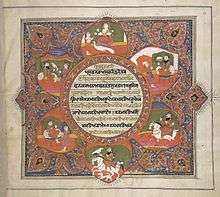 A frontispiece to the Dasam Granth.
A frontispiece to the Dasam Granth.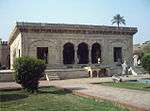 The Bardari of Ranjit Singh, built in the Hazuri Bagh.
The Bardari of Ranjit Singh, built in the Hazuri Bagh. Gateway of the Ram Bagh, North-East of Amritsar; built by Maharajah Ranjit Singh.
Gateway of the Ram Bagh, North-East of Amritsar; built by Maharajah Ranjit Singh.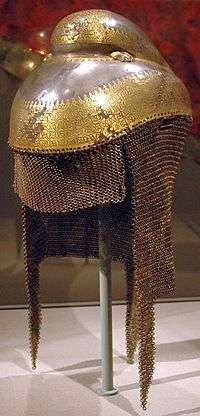 A Sikh helmet from the late 18th century. Note the adaptation on the helmet's crown to allow for a Sikh's uncut hair.
A Sikh helmet from the late 18th century. Note the adaptation on the helmet's crown to allow for a Sikh's uncut hair.- One of the gates at the Sikh temple called Gurdwara Bangla Sahib, in Delhi.
 Illuminated Adi Granth folio with nisan (the Sikh word for flag) of Guru Gobind Singh.
Illuminated Adi Granth folio with nisan (the Sikh word for flag) of Guru Gobind Singh.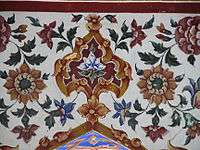 Detail from Gurdwara Baba Atal.
Detail from Gurdwara Baba Atal. A Opaque Watercolour on paper copy of Nakashi 1880c
A Opaque Watercolour on paper copy of Nakashi 1880c- Harmandir Sahib or the Golden Temple, Amritsar, India.
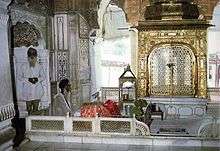 Interior of the Akal Takht.
Interior of the Akal Takht. Painting of the durbar of Maharaja Dalip Singh Sukerchakia.
Painting of the durbar of Maharaja Dalip Singh Sukerchakia. Painting of Ranjit Singh and Hira Singh of Nabha.
Painting of Ranjit Singh and Hira Singh of Nabha. The Sikh Order of Merit with a Portrait of Ranjit Singh, directly inspired by the French Légion d'honneur
The Sikh Order of Merit with a Portrait of Ranjit Singh, directly inspired by the French Légion d'honneur
See also
References and notes
- "Petition to Disaggregate Sikhs Correctly in the 2010 Census". Retrieved 20 November 2014.
- "Memorandum Regarding the Tabulation of Sikh Ethnicity in the United States Census" (PDF). Retrieved 20 November 2014.
- the Crafts of the Punjab
- The magnificence of Sikh architecture Archived 2007-12-14 at the Wayback Machine
- Textile artist Amarjeet Kaur Nandhra
- Singh Twins Art Launches Liverpool Fest
- Re-imagining South Asian Religions: Essays in Honour of Professors Harold G. Coward and Ronald W. Neufeldt
- 31 05 2010 Nidhi Sharma for RT
- Himadri Banerjee Institute of Sikh Studies
- Office of the Registrar General and Census Commissioner (2001). "Census of India 2001: Population by religious communities". Government of India. Retrieved 3 January 2010.
- The Tribune Surjit Hans 24 08 2003
- Deccan Hrald 23 04 2012
- "Sikhs and Sikhism in Eastern and North-Eastern India". Institute of Sikh Studies.
- Calcutta Mosaic: Essays and Interviews on the Minority Communities of Calcutta : edited by Nilanjana Gupta, Himadri Banerjee, Sipra Mukherjee
- Zee New 18 10 2011
- The Tribune 28 10 2014 Birinder Pal Singh
- Kashur The Kashmiri Speaking People By Mohini Qasba Raina